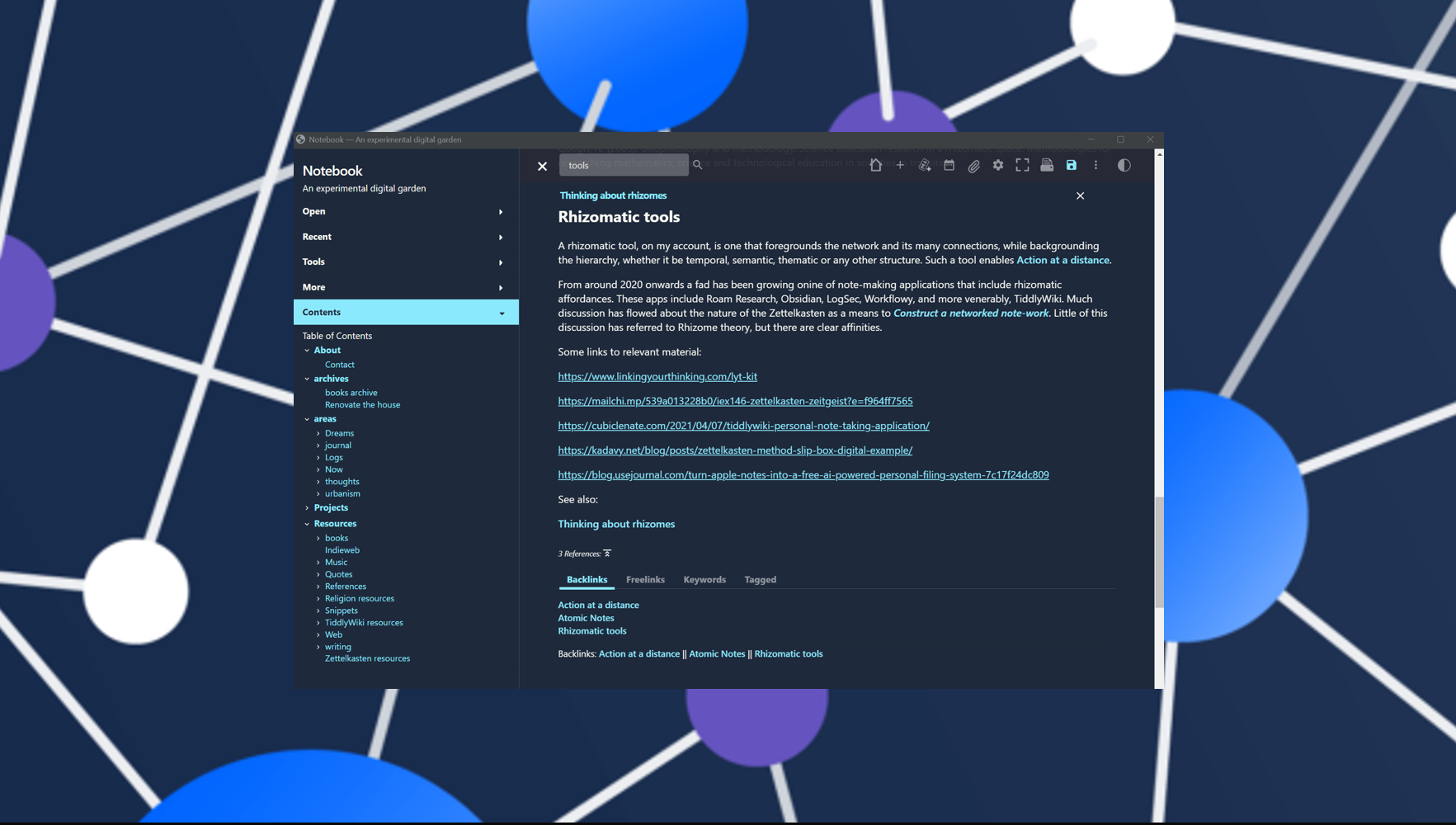My favourite tool is this notebook I made
I couldn’t find a note-making app that really suited me so I made one myself.
OK, that’s a bit of a stretch. It’s really just a heavily modified version of TiddlyWiki but it feels tailor-made. And working with it fits me like a glove. It’s a great example of making a creative working environment. That’s important. You have to make your own environment. Some people hate TiddlyWiki1. That’s fine too.
I wanted a notemaking environment that would let me:
- write atomic notes,
- write in Markdown syntax,
- link notes easily,
- re-combine notes by transclusion,
- easily search through all my notes without clutter; and
- export notes without stress.

Here’s how I made my personalised notemaking app.
- Base: TiddlyWiki. I can’t stand the look of the plain OG version but I love the notebook theme that can easily be added.
- Backlinks: To enable backlinks I have found a couple of basic plug-ins really useful and would strongly recommend:
- TWCrossLinks. This adds a footer to your notes to show backlinks and freelinks.
- Relink. This enables automatic renaming of titles and other items across links.
- To-Do: For a to-do list, I greatly admire Projectify, which I have used for work, but for personal use I like the super-simple but effective Chandler, written by the late Joe Armstrong (godfather of Haskell). He talks you through how he wrote it, which in itself is a mini-masterclass in how to customise TiddlyWiki.
- Help: Finally I’ll mention the active and very helpful TiddlyWiki user forum.
I see TiddlyWiki as a rhizomatic tool - one of several. A rhizomatic tool, the way I see it, is one that foregrounds the network and its many connections, while pushing to the background the hierarchy, whether it be temporal, semantic, thematic or any other structure. Such a tool helps users to create “mobile, stable and combinable inscriptions” that enable “action at a distance” (Latour, 1987).
Since about 2020 a fad has been growing online of note-making apps that include rhizomatic affordances. That’s a fancy way of saying lotsalinks. These internal-link-friendly apps include Roam Research, Obsidian, LogSeq, Workflowy, and more venerably, TiddlyWiki. Much discussion has flowed about the nature of the Zettelkasten as a means to construct a networked system of notes. Little of this discussion has referred directly to Rhizome theory, but there are clear affinities.
I wanted a rhizomatic tool for writing, and since I couldn’t find one I really liked, I adapted one for my own purposes. You might not need to invent your own tools, but each of us gathers uniquely the unique contents of our own toolbox.
This post is a contribution to the ongoing Indieweb Carnival, July 2024 edition. Why not check out the other posts, on tools, and contribute yourself to August’s theme, which is rituals.
Some links to relevant material:
Does the Zettelkasten have a top and a bottom?
A network of notes is a rhizome not a tree
Inspired destruction: How a Zettelkasten explodes thoughts so you can have newish ones
Zettelkasten, Rhizomes, and You
A great summary of TiddlyWiki
The rise of networked notetaking
Deleuze, Gilles and Félix Guattari (2004/1980). Rhizome PDF. In A Thousand Plateaus: Capitalism and Schizophrenia, trans. Brian Massumi. New York: Continuum, pp. 3-28.
Latour, B. (1987), Science in Action: How to Follow Scientists and Engineers through Society, Harvard University Press, Cambridge, MA.
-
Me too! I hate the name TiddlyWiki, and I hate the word ‘tiddler’ and generally I hate the aesthetic. That’s why I’ve changed it. ↩︎